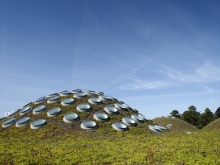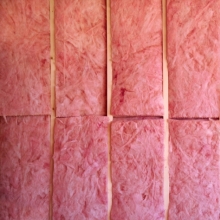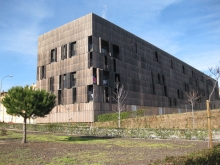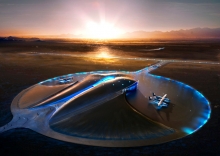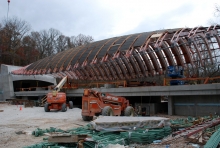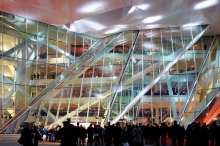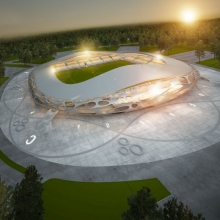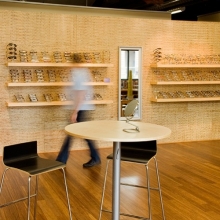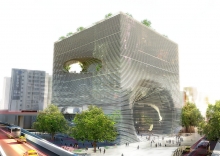Your eyes sweep across the panorama. Rolling hills are bursting with colorful wildflowers of vivid orange, yellow, and purple. A Bay Checkerspot butterfly dances by in the flickering light reflected by what looks like a pond but is in fact a skylight of Renzo Piano’s California Academy of Sciences building. Piano worked with Academy scientists and a team of California professionals, including Stantec Architecture from San Francisco, to revitalize the California Academy of Sciences building, located in San Francisco's Golden Gate Park.
AEC Pros
Spaceport America: High Performance Construction in the New Mexican Desert
It seems totally appropriate that the Mesilla Valley in Southern New Mexico is the site of one of the world’s most exciting feats of modern human exploration. Ever since the 1500s when Spanish Conquistadors scouted this beautiful valley along the Rio Grande River, this enchanted territory has seen travelers, traders, and tourists pass through its hostile reaches in search of better lives and new horizons. In the past, the Mesilla Valley was a place to pass through along the historic Camino Real for travelers on the trade route from Mexico City to Santa Fe. In the future, however, it will be an exciting destination, with the development of Spaceport America, the world’s first private spaceport.
ROI-Driven Products: Insulation
In this second addition of “ROI-Driven Products," we take a look at insulation, which is a big part of a building’s envelope. When insulation is installed correctly, it provides the necessary R-value to meet the thermal demands of the region and the comfort demands of the building’s occupants. With energy prices on the rise, building envelopes have come under more and more scrutiny. Homeowners and business owners alike are now seeing the need to improve the building envelope and increase its overall efficiency.
Bamboo Housing in Carabanchel by Foreign Office Architects (FOA)
It’s official: architects are in love with bamboo. A tree-hugging designer’s dream, bamboo is an eco-friendly, versatile, and durable material. More importantly, bamboo is the fastest growing perennial on the planet, making it symbolically a perfect choice for a city like Madrid, with its ever growing population and, subsequently, its enormous need for public housing. Located in the Carabanchel district, a “regeneration area” on the outskirts of Madrid, Carabanchel Social Housing is a state-subsidized, five-story residential project with 100 units, covered with bamboo louvres. (The structure itself is not made of bamboo, but bamboo is very prominent in the primary architectural statement it makes, due to the louvers.) Foreign Office Architects (FOA) credit Farshid Moussavi, Alejandro Zaera Polo, and others at FOA for Carabanchel Social Housing’s innovative design, which merges an environmentally conscious model with the social urbanization needs of the 21st century. One of the largest social housing projects in Europe, it was completed in late 2007.
The winning competition entry that Foster + Partners provided to the New Mexico Spaceport Authority makes no reference to the innate femininity of the firm’s design for Virgin Galactic’s Terminal and Hangar Facility at Spaceport America in southern New Mexico. My response to this intuitively sensual design, however, was an immediate attraction to the curvaceous feminine symbology of the Terminal building.
From the Job Site: Crystal Bridges Museum of American Art
Construction of the Crystal Bridges Museum of American Art, located in Bentonville, Arkansas, has come far, far enough that the completion schedule has been finalized. Opening of the Crystal Bridges Museum has been set for November 11, 2011: the end of a long process is finally in sight. Construction began in 2006 and has progressed steadily. The project is complex, the site is challenging, and the buildings themselves have unusual features.
Solar Renewable Energy Certificates (SRECs)
Solar projects have taken off around the United States and the rest of the world in the past few years, partly because of higher energy costs and increases in financing options. The U.S. federal government has created many such options, including tax credits and grants. Lately, solar renewable energy certificate (SREC) programs at the state level have caught the industry’s attention. SRECs have begun to take shape as creative financing tools for all types of solar projects. In both residential and commercial projects, SRECs have proven to be the difference in financial feasibility.
Sometimes breath-taking beauty and fantastic design can be born from a virtually blank landscape, and the Grand Canal Square Theatre and Commercial Development proves just that. For years, the Grand Canal Harbour waterfront in Dublin, Ireland, was simply a deserted former industrial site. All that changed when the Dublin Docklands Authority set out to redevelop the abandoned area and create a multipurpose cultural civic center for Dublin. World-renowned architect Daniel Libeskind and landscape architects from Martha Schwartz Partners collaborated on the project to create an architectural masterpiece that merges aesthetic appeal, functionality, and sustainability.
A Spectator Sport: FC Bate Borisov Stadium by Ofis arhitekti
In just about every part of the world not the United States -- the only country that dares to use the word "soccer" -- the sport of football makes for extremely important events. It is no surprise that many football stadiums feature impressive architectural design, such as the Bird's Nest National Stadium for the 2008 Beijing Olympics by Herzog & de Meuron and the World Cup 2010 stadium in Johannesburg, South Africa, by Populus (formerly HOK Sport) with local firm Boogertman & Partners. Soon to join that list is the FC Bate Borisov Stadium in Belarus by Ofis arhitekti, a Ljubljana, Slovenia-based firm founded by Rok Oman and Spela Videcnik in 1998.
Construction Specifications Institute's (CSI's) GreenFormat
The Construction Specifications Institute (CSI) has been hoping to build upon its 60 year plus history of creating industry standards and guidelines. In December 2008 it introduced GreenFormat, an online search tool that assists designers in finding green building products. GreenFormat ties in with CSI’s existing group of formats, all of which help organize and manage project information (UniFormat, MasterFormat, etc.). Information in GreenFormat is organized according to the already familiar MasterFormat divisions.
Public Space That Doesn't Suck: Bjarke Ingels Group's (BIG) TEK Center
The Bjarke Ingels Group (BIG), a firm based in Denmark, Copenhagen, was founded by namesake Bjarke Ingels in 2006 and has been on the architectural community's radar ever since. BIG's work is known for being simultaneously playful and socially conscientious. Though many of their projects are situated on dense urban sites, BIG often carves outdoor spaces within the vertical confines of buildings. Their Technology, Entertainment and Knowledge (TEK) Center in Taipei, Taiwan continues this trend. Other notable BIG projects include the Danish Pavilion for the Shanghai Expo 2010 and innovative housing projects such as 8Tallet and The Mountain Dwellings, which feature topographically inspired sections that incorporate terraced roof gardens with sweeping views.
IT Infrastructure Case Study: Baldwin-Wallace College Conservatory of Music
Baldwin-Wallace College in Berea, Ohio, is in the midst of a $20.6 million -- $1.2 million of which represents the information technology (IT) portion -- construction project that will double the physical size of its Conservatory of Music. Expected to be completed by the fall of 2011, the project includes major renovations and new construction; joining two existing campus buildings with the adjacent church complex. Upfront planning is crucial to ensure a good IT installation that meets all the needs of their students and professors and wisely uses capital funds. Here are the basic concepts involved in IT system planning and infrastructure. Greg Flanik and Daniel Stilla from Baldwin-Wallace’s IT department provided Buildipedia a look into the planning and technologies involved in getting their new building “wired for sound.”
